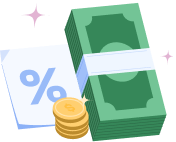Buying a home is a major life milestone, but for many people, a less-than-perfect credit score feels like a wall between them and homeownership. While a good credit score certainly helps secure better loan terms, having bad credit doesn’t necessarily mean you’re shut out from getting a mortgage.
In fact, there are multiple loan options and strategies available for borrowers with poor credit. With careful planning, the right lender, and proactive financial steps, homeownership may still be within reach—even if your credit is far from ideal.
In this article, we’ll explain what constitutes “bad” credit, what mortgage options are available, and how you can improve your chances of approval. We’ll also show how Beem can help you monitor and strengthen your credit as you work toward owning a home.
What Is Considered a “Bad” Credit Score?
Credit scores typically range from 300 to 850. A score below 580 is generally considered “poor” by most lenders. Here’s how FICO scores break down:
- 300–579: Poor
- 580–669: Fair
- 670–739: Good
- 740–799: Very Good
- 800–850: Excellent
A credit score in the “poor” or “fair” range may limit your options when applying for a mortgage. That’s because lenders use your credit score as a key indicator of your ability to repay a loan. Lower scores often signal missed payments, high debt levels, or limited credit history—all of which are considered risk factors.
However, your credit score is only one part of the equation. Lenders also consider income, employment history, debt-to-income ratio, and down payment size when reviewing applications.
Can You Get a Mortgage with Bad Credit?
Yes, you can get a mortgage with bad credit—but it often comes with trade-offs.
Lenders may still approve borrowers with lower credit scores if they can demonstrate stability in other areas, such as consistent income, low debt, or the ability to make a sizable down payment. Certain government-backed loans are designed to help individuals with imperfect credit achieve homeownership.
The catch? You’ll likely face higher interest rates, stricter underwriting, and may be required to provide more documentation to prove you’re a responsible borrower.
Loan Options Available for Bad Credit Borrowers
If your credit score is holding you back, you still have several loan options that cater to lower-score applicants:
FHA Loans
The Federal Housing Administration backs these loans, which are ideal for first-time homebuyers or those with limited credit history. You can qualify with a score as low as 500 if you make a 10% down payment—or 580 with just 3.5% down. These loans come with mortgage insurance, which increases your monthly costs but makes the loan more accessible.
VA Loans
Available to eligible veterans, active-duty service members, and certain military spouses, VA loans don’t require a down payment and often don’t have a minimum credit score requirement. However, most lenders still look for scores of at least 580–620.
USDA Loans
If you’re looking to buy in a rural or suburban area and meet income eligibility guidelines, USDA loans may be a fit. These loans also have no down payment requirements. While the USDA doesn’t set a minimum credit score, most lenders prefer 640+.
Subprime or Non-QM Loans
Some private lenders offer non-qualified (non-QM) loans for those with scores below 600. These loans may have flexible criteria, such as accepting alternative income verification or allowing past credit issues. However, they come with high interest rates and fees, so they should be approached with caution.
Pros and Cons of Each Loan Type
FHA Loans
Pros:
- Low down payment requirements
- Flexible credit criteria
- Ideal for first-time buyers
Cons: - Mortgage insurance is required regardless of down payment size
- Limits on loan amounts depending on your area
VA Loans
Pros:
- No down payment needed
- No private mortgage insurance (PMI)
- Competitive interest rates
Cons: - Only available to eligible military members and their families
- May involve a VA funding fee
USDA Loans
Pros:
- No down payment for qualified buyers
- Lower interest rates
Cons: - Property must be in a USDA-approved rural area
- Income and location restrictions apply
Non-QM/Subprime Loans
Pros:
- More flexible credit and income requirements
Cons: - Higher interest rates and fees
- Not government-backed, so lenders take on more risk (and pass it to you)
Challenges You’ll Face with Bad Credit
Securing a mortgage with bad credit isn’t impossible, but it’s not easy. Be prepared for:
- Higher interest rates: A lower score increases the lender’s risk, so they charge more to compensate. This can mean thousands more in interest over the life of the loan.
- Larger down payment: You may be required to put down 10% or more to offset your credit risk.
- More documentation: Lenders will likely scrutinize your finances in detail. Expect to provide bank statements, tax returns, proof of income, and letters of explanation for past credit issues.
- Limited lender options: Not all lenders work with bad-credit borrowers, which narrows your choices and potentially limits favorable terms.
- Rejection is still a possibility: Especially if you have recent bankruptcies, foreclosures, or collections on your report.
Steps to Increase Mortgage Approval Chances with Bad Credit
Improving your chances of getting approved—even with bad credit—starts with taking the right steps before you apply.
- Raise Your Credit Score: Even a small increase (e.g., from 580 to 620) can unlock better loan options. Start by paying off outstanding debts and making all payments on time.
- Pay Down Debt: Reduce your credit utilization below 30%. This will help improve your credit score and your debt-to-income ratio—both key mortgage factors.
- Dispute Credit Report Errors: Review your reports from all three credit bureaus. If you spot incorrect late payments or accounts that don’t belong to you, dispute them immediately.
- Save for a Larger Down Payment: The more you can put down, the more confidence you instill in the lender. A 10–20% down payment can significantly improve your chances of approval.
- Avoid New Credit Applications: Opening new accounts or taking on additional debt can lower your score and raise red flags.
- Get Pre-Approved: Shop around with different lenders and get pre-approved. This helps you understand your budget and shows sellers you’re serious.
- Consider a Co-Borrower: Applying with a spouse or co-borrower who has better credit can strengthen your application and lead to better loan terms.
Real-Life Example
Suppose your current credit score is 580, and you’re hoping to qualify for an FHA loan. By reducing your credit card balances by 50% and resolving a collection account, your score could improve to 620 in three months—opening up better loan options and reducing your interest rate.
Timing is Key
Try to start preparing your credit 6–12 months before applying for a mortgage. This gives you time to make meaningful changes without rushing through critical decisions.
Track Progress Monthly
Use tools like Beem to check how your efforts are impacting your credit score. This gives you feedback on what’s working and what needs more attention.
How Beem Can Help You Qualify for a Mortgage
Beem helps you take control of your credit and financial profile so you can confidently apply for a mortgage—even with less-than-perfect credit.
Here’s how Beem supports your homeownership journey:
- Credit Monitoring: Track your score and see changes in real-time
- Score Insights: Understand which credit factors need improvement—payment history, utilization, inquiries, etc.
- Alerts: Beem notifies you about due dates, late payments, or major score drops
- Debt and Budget Tools: Plan your down payment savings and pay off high-interest debt
- Custom Tips: Beem gives you personalized actions to raise your score based on your specific credit profile
Beem for First-Time Buyers
Beem is especially helpful if this is your first time applying for a mortgage. From understanding how your score is calculated to creating a realistic debt payoff timeline, Beem simplifies each step.
Build Long-Term Financial Confidence
Even if you’re not ready to apply today, Beem helps you build strong financial habits so that when the time comes, you’re not just qualified—you’re confident.
Thousands of users rely on Beem every day to guide them toward major milestones like homeownership, with fewer surprises and more peace of mind.
Frequently Asked Questions (FAQs) About Can You Get a Mortgage with a Bad Credit Score?
Can you get a mortgage with a bad credit score?
Yes, it’s possible to get a mortgage with bad credit, though your options may be limited. Government-backed loans like FHA, VA, or USDA loans are typically more accessible for buyers with lower credit scores.
What’s considered a bad credit score for a mortgage?
A credit score below 620 is generally considered “bad” for mortgage lending. FHA loans allow scores as low as 500 with a higher down payment.
What is the minimum credit score required for an FHA loan?
You need at least a 500 credit score with a 10% down payment, or a 580 score to qualify with only 3.5% down.
Can I get a mortgage with a 500 credit score?
Yes, but only through an FHA loan and you’ll need at least a 10% down payment. Fewer lenders may be willing to work with this score, and interest rates will likely be higher.
Will a bad credit score increase my mortgage interest rate?
Yes. A lower credit score generally results in a higher interest rate, which means you’ll pay more over the life of the loan.
Do I need a larger down payment if I have bad credit?
Typically, yes. A higher down payment reduces lender risk and can increase your chances of approval.
Can I qualify for a mortgage without a co-signer if I have bad credit?
It’s possible, especially through FHA or VA loans, but having a co-signer with good credit can improve your chances and loan terms.
Will government-backed loans help if I have bad credit?
Yes. FHA, VA, and USDA loans are designed to help borrowers with lower credit scores and limited down payments.
Can I refinance later if my credit score improves?
Yes. Once your credit score improves, you can refinance to lower your interest rate or change loan terms.
Are there homebuyer assistance programs for people with bad credit?
Yes. Many states and municipalities offer down payment assistance or credit counseling programs specifically for first-time and low-credit buyers.
Conclusion
Bad credit doesn’t mean you have to give up on buying a home—it just means you need to be more strategic.
By understanding your loan options, preparing your finances, and using tools like Beem to improve your credit, you can increase your chances of approval and even secure more favorable terms.
Start with your current score, make a plan, and take small, consistent steps. Homeownership may be closer than you think—even with bad credit.
















































